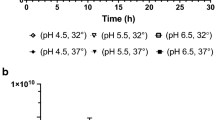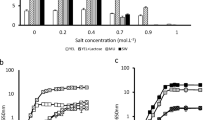Abstract
The production of viable functional probiotics presupposes stability of strain features in the final product. In previous studies, Enterococcus faecium HL7 was found to have relatively higher cell viability after freeze-drying and the long-lasting resistance to heat (60 °C) as well as higher antimicrobial activities against some of fish and human pathogens among isolated strains. For heat adaptation, E. faecium HL7 cells were exposed to 52 °C for 15 min. After adaption, slight decreases of unsaturated membrane fatty acid ratios were confirmed through fatty acid analysis. Upon subsequent exposure to various stress conditions such as H2O2 (0.01%), ethanol (20%), acid (pH 3), and alkali (pH 12), the survival rate of heat-adapted HL7 was 103–105-fold higher than that of non-adapted one. These results highlight the potential of preconditioning treatments for maximizing survival of probiotic bacteria during development of probiotic functional foods. The cross-protection afforded by acid against thermal stress may indicate that certain common protective mechanisms are induced by both heat and acid stress. These results can be applied to enhancing the cell viability during live cell formulation of E. faecium HL7 to be used as a potential probiotics in aquaculture.






Similar content being viewed by others
References
Beal C, Marin M, Fontaine E, Fonseca F, Obert JP (2008) Production et conservation des ferments lactiques et probiotiques. In: Corrieu G, Luquet FM (eds) Bacteries lactiques, de la genetique aux ferments. Tec & Doc Lavoisier, Paris, pp 661–785
Rault A, Bouix M, Beal C (2010) Cryotolerance of Lactobacillus delbrueckii subsp. bulgaricus CFL1 is influenced by the physiological state during fermentation. Int Dairy J 20:792–799
Streit F, Corrieu G, Beal C (2008a) Effect of centrifugation conditions on the cryotolerance of Lactobacillus bulgaricus CFL1. Food Bioprocess Technol 3:36–42
Streit F, Delettre J, Corrieu G, Beal C (2008b) Acid adaptation of Lactobacillus delbrueckii subsp. bulgaricus induces physiological responses at membrane and cytosolic levels that improves cryotolerance. J Appl Microbiol 105:1071–1080
Hardwood VJ, Whitlock J, Withighton V (2000) Classification of antibiotic resistance patterns of indicator bacteria by discriminant analysis: use in predicting the source of fecal contamination in subtropical waters. Appl Environ Microbiol 66:3698–3704
Wilson IG, McAfee GG (2002) Vancomycin-resistant enterococci in shellfish, unchlorinated waters, and chicken. Int J Food Microbiol 79:143–151
Petersen A, Dalsgaard A (2003) Antimicrobial resistance of intestinal Aeromonas spp. and Enterococcus spp. in fish cultured in integrated broiler-fish farms in Thailand. Aquaculture 219:71–82
Franz CMAP, Stiles ME, Schleifer KH, Holzapfel WH (2003) Enterococci in foods a conundrum for food safety. Int J Food Microbiol 88:105–122
Ghazala S, Coxworthy D, Alkanani T (1995) Thermal kinetics of Streptococcus faecium in nutrient broth/sous vide products under pasteurization conditions. J Food Process Preserv 19:243–257
Martínez S, López M, Bernardo A (2003) Thermal inactivation of Enterococcus faecium: effect of growth temperature and physiological state of microbial cells. Lett Appl Microbiol 37:475–481
Giraffa G, Carminati D, Neviani E (1997) Enterococci isolated from dairy products: a review of risks and potential technological use. J Food Prot 60:732–738
Tosun H, Gönü SA (2003) Acid adaptation protects Salmonella typhimurium from environmental stress. Turk J Biol 27:31–36
Álvarez-Ordóñez A, Fernández A, López M, Arenas R, Bernardo A (2008) Modifications in membrane fatty acid composition of Salmonella typhimurium in response to growth conditions and their effect on heat resistance. Int J Food Microbiol 123:212–219
Leyer GJ, Johnson EA (1993) Acid adaptation induces cross-protection against environmental stresses in Salmonella typhimurium. Appl Environ Microbiol 59:1842–1847
Ryu JH, Beuchat LR (1998) Influence of acid tolerance responses on survival, growth, and thermal cross-protection of Escherichia coli O157:H7 in acidified media and fruit juices. Int J Food Microbiol 45:185–193
Kim WR, Kang CH, Gu T, Shin YJ, Jang S, Jung J, So JS (2016) Screening of lactic acid bacteria as potential probiotics in aquaculture and improvement of cell viability by heat adaptation. 2016 KSBB Spring Meeting and International Symposium, 182–182
Hartke A, Bouche S, Giard JC, Benachour A, Boutibonnes P, Auffray Y (1996) The lactic acid stress response of Lactococcus lactis subsp. lactis. Curr Microbiol 33:194–199
Beal C, Fonseca F, Corrieu G (2001) Resistance to freezing and frozen storage of Streptococcus thermophilus is related to membrane fatty acid composition. J Dairy Sci 84:2347–2356
Wang Y, Corrieu G, Beal C (2005) Fermentation pH and temperature influence the cryotolerance of Lactobacillus acidophilus RD758. J Dairy Sci 88:21–29
Prescott LM, Harley JP, Klein DA (1990) Microbiology. Dubuque, IA
Saarela M, Rantala M, Hallamaa K, Nohynek L, Virkajarvi I, Matto J (2004) Stationary phase acid and heat treatments for improvement of the viability of probiotic lactobacilli and bifidobacteria. J Appl Microbiol 96:1205–1214
Kloss WE (1998) Staphylococcus. In: Collier L, Balows A, Sussman M (eds) Topley & Wilson’s microbiology and microbial infections, 9th edn. Arnold (Hodder Headline Group), London, pp 577–632
Wade JJ (1997) Enterococcus faecium in hospitals. Eur J Clin Microbiol Infect Dis 16:113–119
Gottesman S (1996) Proteases and their targets in Escherichia coli. Annu Rev Genet 30:465–506
Laport MS, da Silva MR, Silva CC, de Freire Bastos MC, Giambiagi-deMarval M (2003) Heat-resistance and heat-shock response in the nosocomial pathogen Enterococcus faecium. Curr Microbiol 46:313–317
Kim JH, Lee SY, Chang CE, Kim SC, Yun HS, So JS (2001) Effect of cold adaptation on the improved viability of Lactobacillus crispatus KLB46. Korean J Biotechnol Bioeng 16:626–631
Sörqvist S (2003) Heat resistance in liquids of Enterococcus spp., Listeria spp., Escherichia coli, Yersinia enterocolitica, Salmonella spp. and Campylobacter spp. Acta Vet Scand 44:1–19
Goldstein JN, Pollitt S, Inouye M (1990) Major cold shock protein of Escherichia coli. Proc Natl Acad Sci U S A 87:283–287
Lin J, Smith MP, Chapin KC, Baik HS, Bennet GN, Foster JW (1996) Mechanisms of acid resistance in enterohemorrhagic Escherichia coli. Appl Environ Microbiol 62:3094–3100
Sampathkumar B, Khachatourians GG, Korber DR (2004) Treatment of Salmonella enterica serovar Enteritidis with a sublethal concentration of trisodium phosphate or alkaline pH induces thermotolerance. Appl Environ Microbiol 70:4613–4620
Álvarez-Ordóñez A, Fernández A, López M, Bernardo A (2009) Relationship between membrane fatty acid composition and heat resistance of acid and cold stressed Salmonella senftenberg CECT 4384. Food Microbiol 26:347–353
Annous BA, Kozempel MF, Kurantz MJ (1999) Changes in membrane fatty acid composition of Pediococcus sp. strain NRRL B-2354 in response to growth conditions and its effect on thermal resistance. Appl Environ Microbiol 65:2857–2862
De Vries W, Stouthamer AH (1969) Factors determining the degree of anaerobiosis of Bifidobacterium strains. Arch Mikrobiol 65:275–287
Dukan SAM, Touati D (1996) Hypochlorous acid stress in Escherichia coli: resistance, DNA damage, and comparison with hydrogen peroxide stress. J Bacteriol 178:6145–6150
Santivarangkna C, Kulozik U, Foerst P (2007) Alternative drying processes for the industrial preservation of lactic acid starter cultures. Biotechnol Prog 23:302–315
Quivey RG Jr, Faustoferri R, Monahan K, Marquis R (2000) Shifts in membrane fatty acid profiles associated with acid adaptation of Streptococcus mutans. FEMS Microbiol Lett 189:89–92
Presser KA, Ratkowsky DA, Ross T (1997) Modelling the growth rate of Escherichia coli as a function of pH and lactic acid concentration. Appl Environ Microbiol 63:2355–2360
Zotta T, Ricciardi A, Ciocia F, Rossano R, Parente E (2008) Diversity of stress responses in dairy thermophilic streptococci. Int J Food Microbiol 124:34–42
Serrazanetti D, Guerzoni ME, Corsetti A, Vogel R (2009) Metabolic impact and potential exploitation of the stress reactions in lactobacilli. Food Microbiol 26:700–711
Ferrando V, Quiberoni A, Reinheimer J, Suárez V (2015) Resistance of functional Lactobacillus plantarum strains against food stress conditions. Food Microbiol 48:63–71
Pichereau V, Hartke A, Auffray Y (2000) Starvation and osmotic induced multiresistances: influence of extracellular compounds. Int J Food Microbiol 55:19–25
Mackay BM, Derrick CM (1996) Elevation of the heat resistance of Salmonella typhimurium by sublethal heat shock. J Appl Bacteriol 61:389–393
Teixeira P, Castro H, Kirby R (1994) Inducible thermotolerance in Lactobacillus bulgaricus. Lett Appl Microbiol 18:218–221
Heunis T, Deane S, Smit S, Dicks L (2014) Proteomic profiling of the acid stress response in Lactobacillus plantarum 423. J Proteome Res 13:4028–4039
Lorca GL, de Valdez GF (1999) The effect of suboptimal growth temperature and growth phase on resistance of Lactobacillus acidophilus to environmental stress. Cryobiology 39:44–149
Wang YC, Yu RC, Chou CC (2004) Viability of lactic acid bacteria and Bifidobacteria in fermented soymilk after drying, subsequent rehydration and storage. Int J Food Microbiol 93:209–217
Leslie SB, Israeli E, Lighthart B, Crowe JH, Crowe LM (1995) Trehalose and sucrose protect both membranes and proteins in intact bacteria during drying. Appl Environ Microbiol 61:3592–3597
Castro HP, Teixeira PM, Kirby R (1997) Evidence of membrane damage in Lactobacillus bulgaricus during storage following freeze-drying. J Appl Microbiol 82:87–94
Tsvetkov T, Brankova R (1983) Viability of micrococci and lactobacilli upon freezing and freeze-drying in the presence of different cryoprotectants. Cryobiology 20:318–323
Fonseca F, Beal C, Corrieu G (2000) Method of quantifying the loss of acidification activity of lactic acid starters during freezing and frozen storage. J Dairy Res 67:83–90
Acknowledgements
This work was supported by INHA UNIVERSITY RESEARCH grant.
Author information
Authors and Affiliations
Corresponding author
Ethics declarations
Conflict of Interest
The authors declare that they have no conflict of interest.
Rights and permissions
About this article
Cite this article
Shin, Y., Kang, CH., Kim, W. et al. Heat Adaptation Improved Cell Viability of Probiotic Enterococcus faecium HL7 upon Various Environmental Stresses. Probiotics & Antimicro. Prot. 11, 618–626 (2019). https://doi.org/10.1007/s12602-018-9400-4
Published:
Issue Date:
DOI: https://doi.org/10.1007/s12602-018-9400-4




